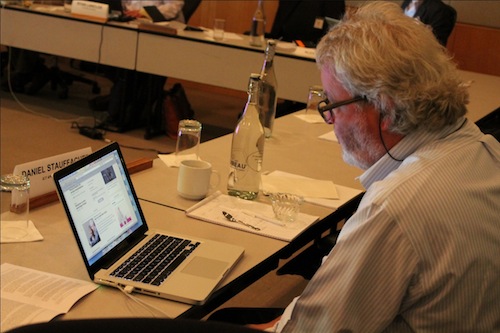The report of the Crisis Information Management CiMAG Retreat, held from 10–12 June 2012 at Dolce Palisades, New York is now available. Please download a copy of it here.
Big themes that emerged during the day included the dual use of technologies and best to create guidance notes and progressive policies regarding this (e.g. Big Data could be both very useful and lead to privacy nightmares and possibly even border on surveillance in less democratic regimes). It was also flagged that the sheer volume of data could, given the myriad of metrics collected for each customer on mobile networks, and user of web based social networks for example, lead to a high accuracy in determining personal information, including traits, credit history and location data. Given that the likes of CNN and Facebook had asked the UN to present a coherent approach if they wanted to be featured primus inter pares in their respective information space, it was asked as to what the UN could do in this regard.
There were concerns over the privatisation of CiM and crisis related information, with the likes of Google, Twitter, Microsoft and Facebook now as corporations involved in data collection, archival and dissemination that is fundamentally different to the operational ethics, guidelines, practices and standards of the UN system, with obvious concerns over data retention, use and release. There were questions over the effectiveness and efficiency gains, if any, with the use of social media and bounded crowdsourcing. Some participants flagged that the selection of the bounded crowdsourcing frame impacted the nature of the information produced, which can be very important to not forget when dealing with Complex Political Emergencies (CPEs). It was noted that CiM tools, practices and platforms that worked for humanitarian disasters would not be those most appropriate for generating, capturing, archiving and analysing information around CPEs. Questions were also raised on the statistical models for social media in CiM and whether social media based situational awareness was most useful and appropriate only in high frequency, geographically framed contexts, and that difficulties over verification when they were few and far between undermined social media’s value. The issue of translations was flagged, and the idea was mooted whether the CiMAG could be a marketplace of ideas responding to challenges faced by its constituency members.
Overall, CiMAG members discussed whether anyone, including the UN system, had a full understanding over the risks of using crowd-sourced information. It was noted that the debate wasn’t about whether to use crowd sourced information or not, but how best to do it in light of the larger responsibilities of the UN system to its stakeholders and member states. It was also repeated, as with CiMAG meetings before, that those involved in CiM needed to institutionalise CiM practices, policies and platforms before a crisis, and not just start thinking about them after one. Re-purposing existing platforms was noted to be far more effective than the sudden introduction of new platforms, no matter how good they were. Some said that it was important to listen carefully first before protecting one’s own pre-suppositions and biases towards the information received from the field, especially from CPEs and humanitarian emergencies within CPEs. Around stakeholder management, there was also some discussion over the need to create more CiM API’s for the UN, and that one of the best uses of Global Pulse within the UN system would be to see it as a service, and less as a standalone platform or initiative.
Photos from Day 1 and Day 2 of the retreat are below.

